Should You Consider Drip Irrigation for Your Trees?
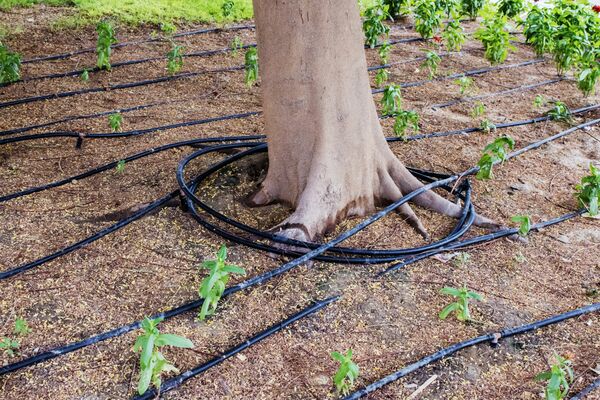
Introduction
Proper hydration stands as the cornerstone of healthy trees and vibrant landscapes. Signs of under-watered trees, like dry, curled-up leaves or compromised canopies, underscore the necessity for effective watering methods. Could drip irrigation hold the key to addressing these challenges? Explore why adopting this system for your trees and shrubs is a transformative choice.
Drip systems redefine tree care with targeted root nourishment, promoting robust growth and precise hydration tailored to each plant's needs. By minimizing water wastage through direct root delivery, they champion conservation efforts and reduce utility bills. This article unveils the efficacy of drip irrigation, delving into optimizing water flow rates, automation options, and practical installation tips.
In a succinct guide, discover the secrets behind drip irrigation's efficiency and its role in sustaining healthy trees. Learn installation nuances and ongoing maintenance tips for a seamless, customized watering system.
Why Drip Irrigation for Your Trees is a Wise Choice
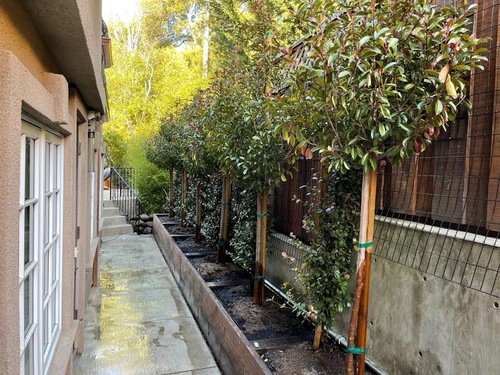
A Walkway Lined with Trees Fitted with Drip Irrigation
Drip irrigation offers a host of benefits that make it an appealing choice for tree care:
Targeted Water Delivery
Instead of having to water your trees from above ground, drip systems directly nourish tree roots, fostering deep root growth. This targeted approach encourages healthier trees and shrubs.
Precision in Watering
Providing precise amounts of water tailored to each plant’s needs is a vast improvement over the guesswork involved in traditional watering methods like hoses or sprinklers.
Reduction in Water Waste
By delivering water directly to the roots, drip irrigation minimizes wastage through runoff or evaporation, leading to decreased utility bills and conserving water resources.
Choosing the Right Dripper Flow Rate
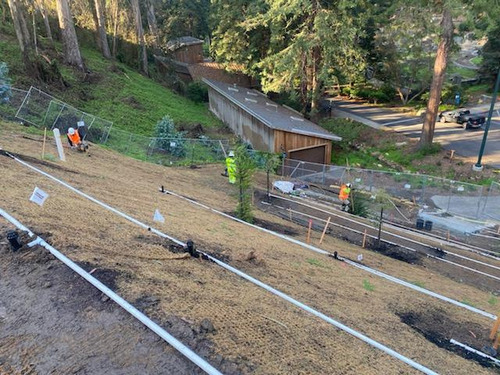
Workers Installing Drip Irrigation on a Slope
Understanding Flow Rates
Selecting the appropriate dripper flow rate is crucial for optimizing water delivery to your trees. Flow rates, typically measured in gallons per hour (GPH) or liters per hour (LPH), determine the volume of water emitted by each dripper over a specific time.
Factors Influencing Flow Rates
- Soil Type: Different soil types have varying absorption rates. Sandy soils may require lower flow rates to prevent water wastage, while clay soils might benefit from slightly higher rates to ensure adequate water penetration.
- Plant Needs: Consider the water requirements of your trees and shrubs. Younger or more delicate plants might need lower flow rates to avoid overwhelming them with excessive water.
- Climate and Evaporation: Hotter climates or areas with high evaporation rates may necessitate higher flow rates to compensate for water loss.
Matching Flow Rates to Tree Needs
- Tree Size and Age: Younger trees typically require less water than mature ones. Adjust flow rates accordingly to meet the specific needs of each tree.
- Root Depth: Understanding the depth of your tree’s root system can aid in selecting appropriate flow rates. Deeper roots may require higher flow rates to ensure water reaches them effectively.
- Environmental Factors: Consider factors like sun exposure, wind conditions, and seasonal variations to fine-tune your dripper flow rates for optimal tree health.
Automation Options for Drip Irrigation
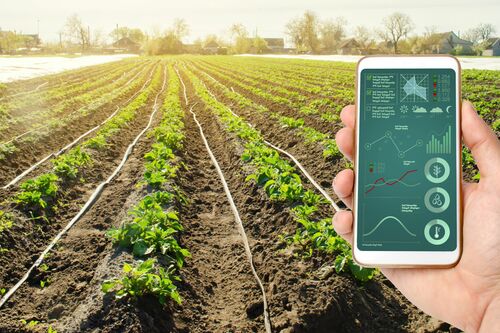
A Smartphone App Being Used to Monitor Agricultural Drip Irrigation
Timers and Controllers
Automating your drip irrigation system can streamline the watering process and ensure consistency in watering schedules.
- Digital Timers: These easily programmable devices control the duration and frequency of watering sessions. They offer flexibility in scheduling and can be adjusted based on changing weather conditions.
- Smart Controllers: These advanced systems utilize weather data and soil moisture sensors to automatically adjust watering schedules. They optimize water usage based on real-time environmental conditions, reducing water wastage and promoting efficient irrigation.
Drip System Add-ons for Automation
- Moisture Sensors: These devices measure soil moisture levels and relay information to the controller. They help prevent overwatering or underwatering by ensuring trees receive the right amount of water when needed.
- Rain Sensors: These tools automatically suspend irrigation during rainy periods, preventing unnecessary watering and conserving water resources.
Benefits of Automation
- Consistency: Automated systems ensure consistent watering, which is crucial for maintaining tree health.
- Water Efficiency: By adjusting watering schedules based on real-time conditions, automation minimizes water wastage and promotes conservation.
Incorporating the right dripper flow rates and automation options into your drip irrigation system can significantly enhance its effectiveness and efficiency, providing tailored care to your trees.
Embracing drip irrigation promises efficiency and improved tree health, but how do you set up such a system?
Installing Your Drip Irrigation System
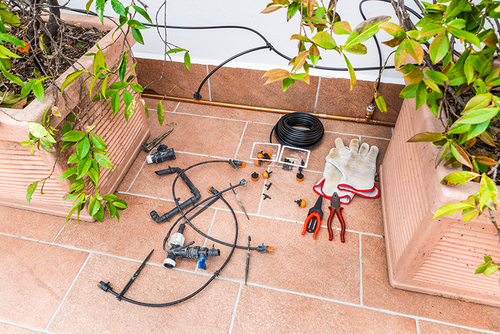
A DIY Home Drip Irrigation Kit
DIY Installation
For DIY enthusiasts, ready-made drip irrigation kits available online or at local garden centers offer convenience. These kits typically include tubing to run from the water supply to the tree, fittings to attach the hose to the system, stakes to secure the tubing to the ground, and emitters to transport the water from the tubing to the tree bed.
- Placement: Lay the tubing around the tree, midway between the canopy edge and the trunk.
- Emitter Attachment: Connect emitters to the tubing and secure them into the soil with the stakes.
- Connection: Link the system to your faucet and secure the tubing.
If you are only using drip irrigation for a few big trees, here are some more specific tips as well.
Routine Care
- Regular Maintenance: Check the system monthly for potential clogs, especially with hard water. Monitor soil moisture levels to fine-tune watering adjustments based on rainfall.
- Winter Precautions: In areas with harsh winters, drain and cover the system in autumn to prevent freeze damage.
Hiring a Professional
If the DIY route seems daunting, consulting a local tree care or landscaping professional can provide expertise in installing and maintaining a drip irrigation system. For those in the San Mateo or San Francisco Bay Area, Arborist Now offers assistance in watering trees.
Drip Irrigation vs. Other Methods
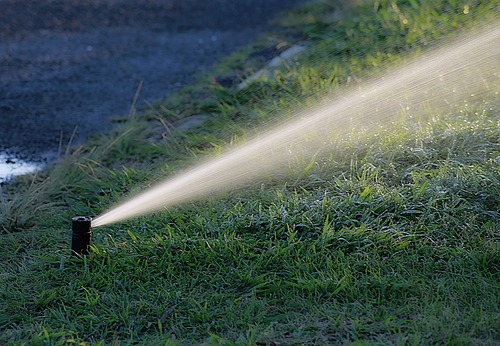
A Lawn Sprinkler Spraying Water Over Grass
When considering irrigation methods for your trees, it’s essential to weigh the pros and cons of different techniques to make an informed decision.
Drip Irrigation
Advantages:
- Targeted Water Delivery: Drip systems directly nourish the roots, promoting deep root growth and healthier plants.
- Precision in Watering: Tailored watering to individual plant needs ensures optimal hydration without water wastage.
- Water Conservation: Minimal wastage through runoff or evaporation leads to decreased water bills and environmental conservation.
Disadvantages:
- Initial Investment: Setting up drip systems might require an initial investment and technical know-how.
- Maintenance: Emitters can clog, demanding regular checks and potential adjustments.
Sprinkler Irrigation
Advantages:
- Wide Coverage: Sprinklers effectively cover larger areas, making them suitable for lawns and extensive gardens.
- Ease of Installation: Simple installation process compared to some other methods.
Disadvantages:
- Water Wastage: Significant water loss due to evaporation or wind can lead to inefficiencies.
- Uneven Water Distribution: Areas closest to the sprinkler might receive more water than necessary, potentially causing issues with plant health.
Soaker Hoses
Advantages:
- Even Water Distribution: Soaker hoses distribute water evenly along their length, providing a slow, steady flow.
- Affordability: They are generally more affordable than some other irrigation systems.
Disadvantages:
- Lack of Precision: While they distribute water evenly, soaker hoses might not offer the precision targeting of root zones that drip systems provide.
- Limited Area Coverage: Soaker hoses might not be suitable for larger areas or extensive gardens.
Comparison Summary
Drip Irrigation stands out for its targeted and precise watering, making it an ideal choice for individual trees or shrubs. It minimizes water wastage and fosters healthier root systems.
Sprinkler Irrigation is beneficial for larger areas but may result in water wastage due to its wide coverage and potentially uneven distribution.
Soaker Hoses are cost-effective and provide even watering but might lack the precision targeting of root zones that drip systems offer, limiting their suitability for certain landscapes.
Common Drip Irrigation Mistakes to Avoid
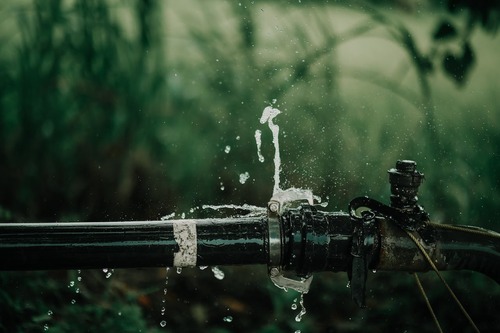
Water Leaking from a Damaged Drip Irrigation Pipe
While drip irrigation offers numerous benefits, certain common mistakes can hinder its effectiveness. Being aware of these pitfalls can help you avoid potential issues and ensure your system functions optimally.
Incorrect Placement of Emitters
- Mistake: Placing emitters too close or too far from the tree’s root zone can result in under- or overwatering.
- Solution: Position emitters midway between the canopy edge and the trunk, ensuring water reaches the critical root areas for effective hydration.
Ignoring Regular Maintenance
- Mistake: Neglecting routine checks for clogs or damaged components can lead to system inefficiencies and plant stress.
- Solution: Regularly inspect the system for clogs, especially in areas with hard water. Clean or replace clogged emitters promptly to maintain consistent water flow.
Overlooking Soil and Plant Needs
- Mistake: Failing to adjust watering schedules based on soil type, plant age, and environmental factors can lead to inadequate or excessive watering.
- Solution: Consider factors like soil type, plant maturity, and weather conditions when setting drip system schedules. Adapt watering frequency and duration accordingly.
Improper System Design and Sizing
- Mistake: Inadequate planning and incorrect system sizing may result in uneven water distribution or insufficient coverage.
- Solution: Design the system based on the specific needs of your landscape. Consider factors like water pressure, flow rates, and layout to ensure uniform coverage.
Inadequate System Protection
- Mistake: Failing to protect the system from harsh weather conditions or physical damage can lead to system failures.
- Solution: Install protective measures, such as mulch or covers, to shield the system from extreme temperatures or accidental damage, especially during winter.
Lack of Calibration and Testing
- Mistake: Not calibrating the system or neglecting periodic testing can result in inaccurate water delivery.
- Solution: Regularly calibrate and test the system to ensure proper water distribution and adjust settings as needed to maintain efficiency.
Underestimating Maintenance Needs
- Mistake: Assuming drip systems require minimal maintenance can lead to neglect and eventual system deterioration.
- Solution: Implement a regular maintenance schedule that includes checks for leaks, damaged components, and overall system functionality to prevent issues.
By avoiding these common mistakes and taking proactive measures to maintain and optimize your drip irrigation system, you can ensure consistent and efficient watering for your trees and shrubs, promoting their health and vitality.
Potential Downsides of Drip Irrigation
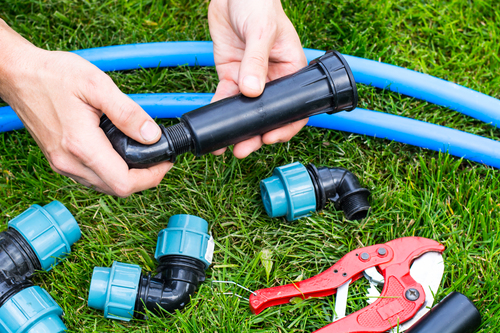
A Drip Irrigation Hose and Various Connectors
While drip irrigation offers numerous benefits, it’s essential to consider its drawbacks:
- Initial Investment: Setting up a drip system might require an initial investment in materials and time for installation.
- Clogging Concerns: Emitters can clog, especially in areas with hard water, necessitating regular maintenance.
- Skill Requirement: DIY installation demands some level of technical skill, and improper setup could affect system efficiency.
Conclusion
Drip irrigation stands as a beacon of precision and efficiency in nurturing trees. While its setup demands initial investment and attention, the benefits far outweigh the challenges. This innovative watering system ensures optimal hydration, fostering vibrant landscapes and sustainable water usage.
Whether opting for a DIY approach or seeking professional guidance, drip irrigation offers a pathway to consistent, efficient tree care. This guide equips you with insights on flow rates, automation, and pitfalls to avoid, empowering you to create thriving outdoor spaces.
In essence, drip irrigation transforms tree care, promising resilience and enduring beauty in your landscape. It's a testament to sustainable practices, enhancing tree health for generations. Embrace drip irrigation—a holistic solution redefining the way we nurture and cherish our trees.
Originally posted on May 16, 2019





